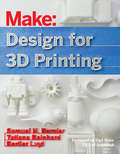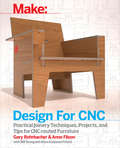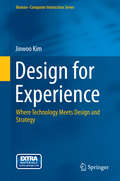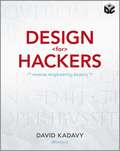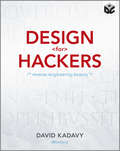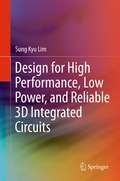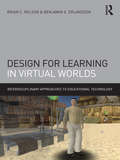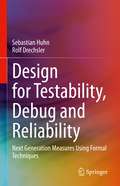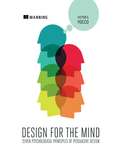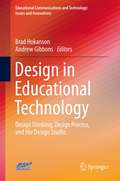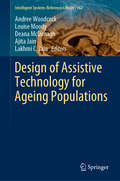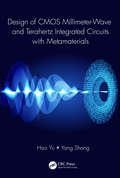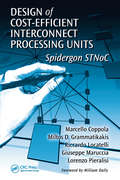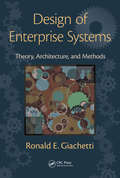- Table View
- List View
Design at Work: Cooperative Design of Computer Systems
by Joan GreenbaumThe contributors to this important volume begin with a simple premise: Computer system development is difficult, not primarily because of the complexity of technical problems, but because of the social interaction involved when users and designers learn to create programs and express ideas together. Based on this important concept, they offer concrete suggestions for ways that system developers can experiment with new perspectives and techniques for cooperating with users -- especially during the early phases of the design process. The editors' primary goal is to stimulate the creation of useful computer systems -- systems that support and sustain the fragile relationship of the people, the working environment, and the computer technology itself.
Design for 3D Printing: Scanning, Creating, Editing, Remixing, and Making in Three Dimensions
by Bertier Luyt Samuel N. Bernier Tatiana ReinhardFrance's Le FabShop has extensive experience testing 3D printers and creating digital models for them. From an articulated Makey Robot to a posable elephant model, Samuel N. Bernier and the rest of Le FabShop's team have created some of the most-printed designs in the 3D printing world. This book uses their work to teach you how to get professional results out of a desktop 3D printer without needing to be trained in design. Through a series of tutorials and case studies, this book gives you the techniques to turn a product idea into a 3D model and a prototype. Focusing on free design software and affordable technologies, the exercises in this book are the perfect boost to any beginner looking to start designing for 3D printing. Designing for the tool and finding a good tool to fit the design--these are at the core of the product designer's job, and these are the tools this book will help you master. Foreword by Carl Bass, Autodesk's CEO, a passionate and prolific Maker. In Design For 3D Printing, you'll:Learn the different 3D printing technologiesChoose the best desktop 3D printerDiscover free 3D modeling softwareBecome familiar with 3D scanning solutionsFind out how to go from a bad to a good 3D source file, one that's ready-to-print
Design for CNC: Furniture Projects and Fabrication Technique
by Anna Kaziunas France Bill Young Gary Rohrbacher Anne FilsonDesign, DIY, and computer-controlled fabrication are a powerful combination for making high-quality customized things. Written by the founders of the architecture, design, and research firm Filson and Rohrbacher, this book takes you through the basics of CNC fabrication, the design process, production, and construction of your own furniture designs. Through their AtFAB series of projects, accompanied by an overview of digital techniques and design thinking, this book introduces the knowledge and skills that you'll find widely applicable across all kinds of CNC projects. Not only will you learn how to design, fabricate, and assemble a wide range of projects, you'll have some great furniture to show for it! While 3D printing has been grabbing headlines, high school, college, library, and other public makerspaces have been making things with CNC machines. With a CNC router, you can cut parts from strong, tactile, durable materials like wood. Once you have your design and material, you can set up your job and let it run. When it's done, you can put the project together for an heirloom of your own. While 3D printing can make exciting things with complex designs, CNCs are the digital workhorses that produce large-scale, long-lasting objects.
Design for Care
by Peter JonesThe world of healthcare is constantly evolving, ever increasing in complexity, costs, and stakeholders, and presenting huge challenges to policy making, decision making and system design. In Design for Care, we'll show how service and information designers can work with practice professionals and patients/advocates to make a positive difference in healthcare.
Design for Developers
by Stephanie StimacSolve common application design and usability issues with flair! These essential design and UX techniques will help you create good user experiences, iterate smoothly on frontend features, and collaborate effectively with designer colleagues.In Design for Developers you will learn how to: Use color, typography, and layout to create hierarchy on a web page Apply color palettes consistently in a user interface Choose the correct typefaces and fonts Conduct user research to validate design decisions Quickly plan a website&’s layout and structure In Design for Developers, author Stephanie Stimac shares the unique insights she&’s learned as a designer on the Microsoft Developer Experiences team. This one-of-a-kind book provides a developer-centric approach to the essential design fundamentals of modern web applications. You&’ll learn how to craft a polished visual design with just color, space, and typeface, and put all your new skills into practice to design a website from scratch. Foreword by Aaron Gustafson. About the technology Developer-made design decisions can have a real impact on a site&’s user experience. Learn to speak design&’s language, and you&’ll be able to confidently contribute to a design process, collaborate with designer colleagues, and make more informed decisions about how you build your apps. About the book Design for Developers reveals essential design and UX principles every web developer needs to know. You&’ll love the book&’s developer-centric approach, which demonstrates new ideas with examples from popular sites and user interfaces. Discover insightful techniques for user research, and learn to use color, typography, and layout to create communicative web visuals. By the time you&’re done reading, you&’ll know it&’s true: having good design sense will make you a better web developer! What's inside Conduct user research to validate design decisions Quickly plan a website&’s layout and structure Iterate smoothly on frontend features Use color, typography, and layout to create hierarchy on a web page About the reader For web developers familiar with HTML, CSS, and the JavaScript basics. About the author Stephanie Stimac is a design technologist and senior product manager who focuses on building and improving developer experiences. She has previously worked on the Microsoft Edge browser. Table of Contents PART 1 DESIGN BASICS 1 Bridging the gap between design and development 2 Design fundamentals PART 2 USER EXPERIENCE 3 User experience basics 4 User research 5 User experience design PART 3 VISUAL DESIGN ELEMENTS 6 Web layout and composition 7 Enhancing web layout with animation 8 Choosing and working with typography on the web 9 Color theory 10 Building a website PART 4 AFTER VISUAL DESIGN 11 Test, validate, iterate 12 Developer choices and user experience
Design for Equality and Justice: INTERACT 2023 IFIP TC 13 Workshops, York, UK, August 28 – September 1, 2023, Revised Selected Papers, Part I (Lecture Notes in Computer Science #14535)
by Marco Winckler José Abdelnour-Nocera Helen Petrie Anna Bramwell-Dicks Abigail EvansThis volume presents a series of revised papers selected from workshops that took place during the 19th IFIP TC13 International Conference on Human-Computer Interaction, INTERACT 2023, held August 28th to September 1st 2023 at the University of York, York, UK. The 54 revised full papers and 21 short papers presented were carefully selected from a competitive selection process. INTERACT 2023 presents the following workshops: WG 13.2 – Human-Centered Software Engineering: Rethinking the Interplay of Human–Computer Interaction and Software Engineering in the Age of Digital Transformation. WG 13.3 – Designing Technology for Neurodivergent Self-Determination: Challenges and Opportunities. WG 13.4/2.7 – HCI-E2-2023: Second IFIP WG 2.7/13.4 Workshop on HCI Engineering Education. WG 13.5 – On Land, at Sea, and in the Air: Human-Computer Interaction in Safety-Critical Spaces of Control. WG 13.6 – Sustainable Human-Work Interaction Designs. WG 13.8 – HCI for Digital Democracy and Citizen Participation. WG 13.10 – Designing for Map-based Interfaces and Interactions. Algorithmic affordances in recommender interfaces. Intelligence Augmentation: Future Directions and Ethical Implications in HCI. Interacting with Assistive Technology (IATech) Workshop. Re-Contextualizing Built Environments: Critical & Inclusive HCI Approaches for Cultural Heritage.
Design for Equality and Justice: INTERACT 2023 IFIP TC 13 Workshops, York, UK, August 28 – September 1, 2023, Revised Selected Papers, Part II (Lecture Notes in Computer Science #14536)
by Marco Winckler José Abdelnour-Nocera Helen Petrie Anna Bramwell-Dicks Abigail EvansThis volume presents a series of revised papers selected from workshops that took place during the 19th IFIP TC13 International Conference on Human-Computer Interaction, INTERACT 2023, held August 28th to September 1st 2023 at the University of York, York, UK. The 54 revised full papers and 21 short papers presented were carefully selected from a competitive selection process. INTERACT 2023 presents the following workshops: WG 13.2 – Human-Centered Software Engineering: Rethinking the Interplay of Human–Computer Interaction and Software Engineering in the Age of Digital Transformation. WG 13.3 – Designing Technology for Neurodivergent Self-Determination: Challenges and Opportunities. WG 13.4/2.7 – HCI-E2-2023: Second IFIP WG 2.7/13.4 Workshop on HCI Engineering Education. WG 13.5 – On Land, at Sea, and in the Air: Human-Computer Interaction in Safety-Critical Spaces of Control. WG 13.6 – Sustainable Human-Work Interaction Designs. WG 13.8 – HCI for Digital Democracy and Citizen Participation. WG 13.10 – Designing for Map-based Interfaces and Interactions. Algorithmic affordances in recommender interfaces. Intelligence Augmentation: Future Directions and Ethical Implications in HCI. Interacting with Assistive Technology (IATech) Workshop. Re-Contextualizing Built Environments: Critical & Inclusive HCI Approaches for Cultural Heritage.
Design for Ergonomics (Springer Series in Design and Innovation #2)
by Francesca TosiThis book focuses on the global quality of the design of systems that people interact with during their work activities and daily lives; a quality that involves the globality of people’s experience – physical, sensory, cognitive and emotional. It presents a concise and structured overview of the ergonomic approach to planning, and of methodological and operational tools from ergonomic research that can more directly and concretely contribute to the design process. The book also explores physical ergonomics and cognitive ergonomics, which are essential components of design culture. The final section addresses the main design problems and intervention criteria regarding the design of environments, products and equipment, as well as the design of communication, training and learning interface systems based on digital technologies. The book is chiefly intended for designers and anyone interested in the methods, tools and opportunities for in-depth analysis and development that ergonomics can offer regarding the conception, production and testing of products, environments and services, whether physical or virtual. It also offers a learning resource for professionals and students in Industrial Design and Planning.
Design for Experience
by Jinwoo KimPresents a strategic perspective and design methodology that guide the process of developing digital products and services that provide 'real experience' to users. Only when the material experienced runs its course to fulfilment is it then regarded as 'real experience' that is distinctively senseful, evaluated as valuable, and harmoniously related to others. Based on the theoretical background of human experience, the book focuses on these three questions: How can we understand the current dominant designs of digital products and services? What are the user experience factors that are critical to provide the real experience? What are the important HCI design elements that can effectively support the various UX factors that are critical to real experience? Design for Experience is intended for people who are interested in the experiences behind the way we use our products and services, for example designers and students interested in interaction, visual graphics and information design or practitioners and entrepreneurs in pursuit of new products or service-based start-ups.
Design for Hackers: Reverse Engineering Beauty
by David KadavyMany design books try to teach design through lists of "do's" and "don'ts." But hackers know you need a deeper understanding of something to really do it well. Design for Hackers takes apart design by "reverse-engineering" Impressionist painting, Renaissance sculpture, the Mac OS X Aqua interface, Twitter's web interface, and much more. You'll learn about color theory, typography, proportions, and design principles. This theoretical advice is mixed with concrete, actionable advice such as suggestions for color scheme tools, and a chart of "all of the fonts you'll ever need".
Design for Hackers: Reverse Engineering Beauty
by David KadavyDiscover the techniques behind beautiful design by deconstructing designs to understand them The term 'hacker' has been redefined to consist of anyone who has an insatiable curiosity as to how things work—and how they can try to make them better. This book is aimed at hackers of all skill levels and explains the classical principles and techniques behind beautiful designs by deconstructing those designs in order to understand what makes them so remarkable. Author and designer David Kadavy provides you with the framework for understanding good design and places a special emphasis on interactive mediums. You'll explore color theory, the role of proportion and geometry in design, and the relationship between medium and form. Packed with unique reverse engineering design examples, this book inspires and encourages you to discover and create new beauty in a variety of formats. Breaks down and studies the classical principles and techniques behind the creation of beautiful design Illustrates cultural and contextual considerations in communicating to a specific audience Discusses why design is important, the purpose of design, the various constraints of design, and how today's fonts are designed with the screen in mind Dissects the elements of color, size, scale, proportion, medium, and form Features a unique range of examples, including the graffiti in the ancient city of Pompeii, the lack of the color black in Monet's art, the style and sleekness of the iPhone, and more By the end of this book, you'll be able to apply the featured design principles to your own web designs, mobile apps, or other digital work.
Design for High Performance, Low Power, and Reliable 3D Integrated Circuits
by Sung Kyu LimThis book provides readers with a variety of algorithms and software tools, dedicated to the physical design of through-silicon-via (TSV) based, three-dimensional integrated circuits. It describes numerous "manufacturing-ready" GDSII-level layouts of TSV-based 3D ICs developed with the tools covered in the book. This book will also feature sign-off level analysis of timing, power, signal integrity, and thermal analysis for 3D IC designs. Full details of the related algorithms will be provided so that the readers will be able not only to grasp the core mechanics of the physical design tools, but also to be able to reproduce and improve upon the results themselves. This book will also offer various design-for-manufacturability (DFM), design-for-reliability (DFR), and design-for-testability (DFT) techniques that are considered critical to the physical design process.
Design for Learning in Virtual Worlds (Interdisciplinary Approaches to Educational Technology)
by Benjamin E. Erlandson Brian C. NelsonDesign for Learning in Virtual Worlds, the first book focused specifically on how to design virtual worlds for educational purposes, explores: * the history and evolution of virtual worlds * the theories behind the use of virtual worlds for learning * the design of curricula in virtual worlds * design guidelines for elements experienced in virtual worlds that support learning * design guidelines for learning quests and activities in virtual worlds. The authors also examine the theories and associated design principles used to create embedded assessments in virtual worlds. Finally, a framework and methodology is provided to assist professionals in evaluating "off-the-shelf" virtual worlds for use in educational and training settings. Design for Learning in Virtual Worlds will be invaluable both as a professional resource and as a textbook for courses within Educational Technology, Learning Sciences, and Library Media programs that focus on gaming or online learning environments.
Design for Software
by Erik KlimczakA unique resource to help software developers create a desirable user experience Today, top-flight software must feature a desirable user experience. This one-of-a-kind book creates a design process specifically for software, making it easy for developers who lack design background to create that compelling user experience. Appealing to both tech-savvy designers and creative-minded technologists, it establishes a hybrid discipline that will produce first-rate software. Illustrated in full color, it shows how to plan and visualize the design to create software that works on every level. Today's software demands attention to the quality of the user experience; this book guides you through a practical design process to achieve that goal Approaches the mechanics of design with a process inspired by art and science Avoids the abstract and moves step by step through techniques you can put to use immediately Covers planning your design, tested methods, how to visualize like a designer, psychology of design, and how to create software that developers will appreciate Explores such elements as choosing the right typeface and managing interactivity Design for Software: A Playbook for Developers brings the art of good design together with the science of software development to create programs with pizazz.
Design for Teaching and Learning in a Networked World: 10th European Conference on Technology Enhanced Learning, EC-TEL 2015, Toledo, Spain, September 15-18, 2015, Proceedings (Lecture Notes in Computer Science #9307)
by Gráinne Conole Johannes Konert Tomaž Klobučar Christoph Rensing Élise LavouéThis book constitutes the refereed proceedings of the 10th European Conference on Technology Enhanced Learning, EC-TEL 2015, held in Toledo, Spain, in September 2015. The 27 full papers, 19 short papers, 9 demo papers and 23 posters were carefully reviewed and selected from 176 submissions. They address topics such as blended learning; self-regulated and self directed learning; reflective learning; intelligent learning systems; learning communities; learning design; learning analytics; learning assessment; personalization and adaptation; serious games; social media; massive open online courses (MOOCs); schools of the future.
Design for Testability, Debug and Reliability: Next Generation Measures Using Formal Techniques
by Rolf Drechsler Sebastian HuhnThis book introduces several novel approaches to pave the way for the next generation of integrated circuits, which can be successfully and reliably integrated, even in safety-critical applications. The authors describe new measures to address the rising challenges in the field of design for testability, debug, and reliability, as strictly required for state-of-the-art circuit designs. In particular, this book combines formal techniques, such as the Satisfiability (SAT) problem and the Bounded Model Checking (BMC), to address the arising challenges concerning the increase in test data volume, as well as test application time and the required reliability. All methods are discussed in detail and evaluated extensively, while considering industry-relevant benchmark candidates. All measures have been integrated into a common framework, which implements standardized software/hardware interfaces.
Design for the Mind: Seven Psychological Principles of Persuasive Design
by Victor YoccoSummaryDesign for the Mind: Seven Psychological Principles of Persuasive Design teaches web designers and developers how to create sites and applications that appeal to our innate natural responses as humans. Author Victor Yocco, a researcher on psychology and communication, introduces the most immediately relevant and applicable psychological concepts, breaks down each theory into easily-digested principles, then shows how they can be used to inform better design.Purchase of the print book includes a free eBook in PDF, Kindle, and ePub formats from Manning Publications.About the TechnologyDesigners and design team members need to think about more than just aesthetics. How do you handle short attention spans. How does your design encourage users to engage, browse, or buy? Fortunately, there are psychological principles that you can use in your design to anticipate and benefit from how humans think, behave, and react.About the BookDesign for the Mind: Seven Psychological Principles of Persuasive Design teaches you to recognize how websites and applications can benefit from an awareness of our innate, natural responses as humans, and to apply the same principles to your own designs. This approachable book introduces the psychological principles, deconstructs each into easily digestible concepts, and then shows how you can apply them. The idea is to deepen your understanding of why people react in the ways they do. After reading the book, you'll be ready to make your work more psychologically friendly, engaging, and persuasive.What's InsideMaking design persuasiveEncouraging visitors to take actionCreating enduring messagesMeeting the needs of both engaged and disengaged visitorsBecoming a strategic influencerApplying theory, with case studies and real-world examplesAbout the ReaderThis book is for web and UX designers and developers as well as anyone involved in customer-facing digital products.About the AuthorVictor Yocco, PhD, is a research director at a Philadelphia-based digital design firm. He received his PhD from The Ohio State University, where his research focused on psychology and communication in informal learning settings. Victor regularly writes and speaks on topics related to the application of psychology to design and addressing the culture of alcohol use in design and technology. He can be found at www.victoryocco.com or @victoryocco on Twitter.Table of ContentsPART 1 INTRODUCING THE APPLICATION OF PSYCHOLOGY TO DESIGNMeeting users' needs: including psychology in designPART 2 WHY DO FOLKS ACT LIKE THAT? PRINCIPLES OF BEHAVIORDesigning for regular use: addressing planned behaviorRisky decisions and mental shortcutsMotivation, ability, and trigger-boom!PART 3 PRINCIPLES OF INFLUENCE AND PERSUASION: NOT AS EVIL AS YOU'D THINKInfluence: getting people to like and use your designUsing family, friends, and social networks to influence usersIt's not what you say; it's how you say it!Persuasion: the deadliest artPART 4 USER EXPERIENCE DESIGN: PUTTING IT ALL TOGETHERCase study: KidTech Design Co.'s Good Choice appThe next step: getting up and running
Design für Testbarkeit, Fehlersuche und Zuverlässigkeit: Maßnahmen der nächsten Generation unter Verwendung formaler Techniken
by Rolf Drechsler Sebastian HuhnIn diesem Buch werden mehrere neue Ansätze vorgestellt, die den Weg für die nächste Generation integrierter Schaltungen ebnen, die auch in sicherheitskritischen Anwendungen erfolgreich und zuverlässig integriert werden können. Die Autoren beschreiben neue Maßnahmen zur Bewältigung der steigenden Herausforderungen im Bereich des Designs für Testbarkeit, Fehlersuche und Zuverlässigkeit, die für moderne Schaltungsentwürfe unbedingt erforderlich sind. Insbesondere werden in diesem Buch formale Techniken wie das Satisfiability (SAT)-Problem und das Bounded Model Checking (BMC) kombiniert, um die entstehenden Herausforderungen in Bezug auf die Zunahme des Testdatenvolumens, die Testanwendungszeit und die erforderliche Zuverlässigkeit zu bewältigen. Alle Methoden werden detailliert diskutiert und unter Berücksichtigung von industrie-relevanten Benchmark-Kandidaten ausführlich evaluiert. Alle Maßnahmen wurden in ein gemeinsames Framework integriert, das standardisierte Software/Hardware-Schnittstellen implementiert.
Design in Educational Technology: Design Thinking, Design Process, and the Design Studio
by Brad Hokanson Andrew GibbonsThis book is the result of a research symposium sponsored by the Association for Educational Communications and Technology [AECT]. The fifteen chapters were developed by leaders in the field and represent the most updated and cutting edge methodology in the areas of instructional design and instructional technology. The broad concepts of design, design thinking, the design process, and the design studio, are identified and they form the framework of the book. This book advocates the conscious adoption of a mindset of design thinking, such as that evident in a range of divergent professions including business, government, and medicine. At its core is a focus on "planning, inventing, making, and doing." (Cross, 1982), all of which are of value to the field of educational technology. Additionally, the book endeavors to develop a deep understanding of the design process in the reader. It is a critical skill, often drawing from other traditional design fields. An examination of the design process as practiced, of new models for design, and of ways to connect theory to the development of educational products are all fully explored with the goal of providing guidance for emerging instructional designers and deepening the practice of more advanced practitioners. Finally, as a large number of leading schools of instructional design have adopted the studio form of education for their professional programs, we include this emerging topic in the book as a practical and focused guide for readers at all levels.
Design of Arithmetic Circuits in Quantum Dot Cellular Automata Nanotechnology
by K. Sridharan Vikramkumar PudiThis research monograph focuses on the design of arithmetic circuits in Quantum Dot Cellular Automata (QCA). Using the fact that the 3-input majority gate is a primitive in QCA, the book sets out to discover hitherto unknown properties of majority logic in the context of arithmetic circuit designs. The pursuit for efficient adders in QCA takes two forms. One involves application of the new results in majority logic to existing adders. The second involves development of a custom adder for QCA technology. A QCA adder named as hybrid adder is proposed and it is shown that it outperforms existing multi-bit adders with respect to area and delay. The work is extended to the design of a low-complexity multiplier for signed numbers in QCA. Furthermore the book explores two aspects unique to QCA technology, namely thermal robustness and the role of interconnects. In addition, the book introduces the reader to QCA layout design and simulation using QCADesigner. Features & Benefits: This research-based book: ·Introduces the reader to Quantum Dot Cellular Automata, an emerging nanotechnology. ·Explores properties of majority logic. ·Demonstrates application of the properties to design efficient arithmetic circuits. ·Guides the reader towards layout design and simulation in QCADesigner.
Design of Assistive Technology for Ageing Populations (Intelligent Systems Reference Library #167)
by Lakhmi C. Jain Louise Moody Andree Woodcock Deana McDonagh Ajita JainThis book focuses on various aspects of research on aging, including in relation to assistive technology; dignity of aging; how technology can support a greater understanding of the experience of physically aging and cognitive changes; mobility issues associated with the elderly; and emerging technologies. The 80+ age group represents an expanding market, with an estimated worth of £21.4 billion a year. Everyone is affected by this shift in demographics – we are getting older and may become carers – and we need to prepare ourselves and adjust our surroundings for longer life. Products, services and environments have been changing in response to the changing population. Presenting international design research to demonstrate the thinking and ideas shaping design, this book is a valuable resource for designers; product developers; employers; gerontologists; and medical, health and service providers; as well as everyone interested in aging.
Design of CMOS Millimeter-Wave and Terahertz Integrated Circuits with Metamaterials
by Hao Yu Yang ShangThis book shows that with the use of metamaterials, one can have coherent THz signal generation, amplification, transmission, and detection for phase-arrayed CMOS transistors with significantly improved performance. Offering detailed coverage from device to system, the book describes the design and application of metamaterials in actual CMOS integrated circuits, includes real circuit examples and chip demonstrations with measurement results, and also evaluates system performance after CMOS-based system-on-chip integration. The book reflects the latest research progress and provides a state-of-the-art reference on CMOS-based metamaterial devices and mm-wave and THz systems.
Design of Cost-Efficient Interconnect Processing Units: Spidergon STNoC (System-on-Chip Design and Technologies)
by Marcello Coppola Miltos D. Grammatikakis Riccardo Locatelli Giuseppe Maruccia Lorenzo PieralisiStreamlined Design Solutions Specifically for NoCTo solve critical network-on-chip (NoC) architecture and design problems related to structure, performance and modularity, engineers generally rely on guidance from the abundance of literature about better-understood system-level interconnection networks. However, on-chip networks present several distinct challenges that require novel and specialized solutions not found in the tried-and-true system-level techniques. A Balanced Analysis of NoC ArchitectureAs the first detailed description of the commercial Spidergon STNoC architecture, Design of Cost-Efficient Interconnect Processing Units: Spidergon STNoC examines the highly regarded, cost-cutting technology that is set to replace well-known shared bus architectures, such as STBus, for demanding multiprocessor system-on-chip (SoC) applications. Employing a balanced, well-organized structure, simple teaching methods, numerous illustrations, and easy-to-understand examples, the authors explain: how the SoC and NoC technology works why developers designed it the way they did the system-level design methodology and tools used to configure the Spidergon STNoC architecture differences in cost structure between NoCs and system-level networks From professionals in computer sciences, electrical engineering, and other related fields, to semiconductor vendors and investors – all readers will appreciate the encyclopedic treatment of background NoC information ranging from CMPs to the basics of interconnection networks. The text introduces innovative system-level design methodology and tools for efficient design space exploration and topology selection. It also provides a wealth of key theoretical and practical MPSoC and NoC topics, such as technological deep sub-micron effects, homogeneous and heterogeneous processor architectures, multicore SoC, interconnect processing units, generic NoC components, and embeddings of common communication patterns. An Arsenal of Practical Learning Tools at Your DisposalThe book features a complimentary CD-ROM for practical training on NoC modeling and design-space exploration. It incorporates the award-winning System C-based On-Chip Communication Network (OCCN) environment, the only open-source network modeling and simulation framework currently available. With its consistent, comprehensive overview of the state of the art – and future trends – of NoC design, this indispensible text can help readers harness the value within the vast and ever-changing world of network-on-chip technology.
Design of Enterprise Systems: Theory, Architecture, and Methods
by Ronald GiachettiIn practice, many different people with backgrounds in many different disciplines contribute to the design of an enterprise. Anyone who makes decisions to change the current enterprise to achieve some preferred structure is considered a designer. What is problematic is how to use the knowledge of separate aspects of the enterprise to achieve a globally optimized enterprise. The synthesis of knowledge from many disciplines to design an enterprise defines the field of enterprise engineering.Because enterprise systems are exceedingly complex, encompassing many independent domains of study, students must first be taught how to think about enterprise systems. Specifically written for advanced and intermediate courses and modules, Design of Enterprise Systems: Theory, Architecture, and Methods takes a system-theoretical perspective of the enterprise. It describes a systematic approach, called the enterprise design method, to design the enterprise. The design method demonstrates the principles, models, methods, and tools needed to design enterprise systems. The author uses the enterprise system design methodology to organize the chapters to mimic the completion of an actual project. Thus, the book details the enterprise engineering process from initial conceptualization of an enterprise to its final design.Pedagogical tools available include:For instructors: PowerPoint® slides for each chapter Project case studies that can be assigned as long-term projects to accompany the text Quiz questions for each chapter Business Process Analyzer software available for download For students: Templates, checklists, forms, and models to support enterprise engineering activities The book fills a need for greater design content in engineering curricula by describing how to design enterprise systems. Inclusion of design is also critical for business students, since they must realize the import their decisions may have on the long-term design of the enterprises they work with. The book’s practical focus and project-based approach coupled with the pedagogical tools gives students the knowledge and skills they need to lead enterprise engineering projects.
Design of Experiments for Reinforcement Learning
by Christopher GattiThis thesis takes an empirical approach to understanding of the behavior and interactions between the two main components of reinforcement learning: the learning algorithm and the functional representation of learned knowledge. The author approaches these entities using design of experiments not commonly employed to study machine learning methods. The results outlined in this work provide insight as to what enables and what has an effect on successful reinforcement learning implementations so that this learning method can be applied to more challenging problems.

